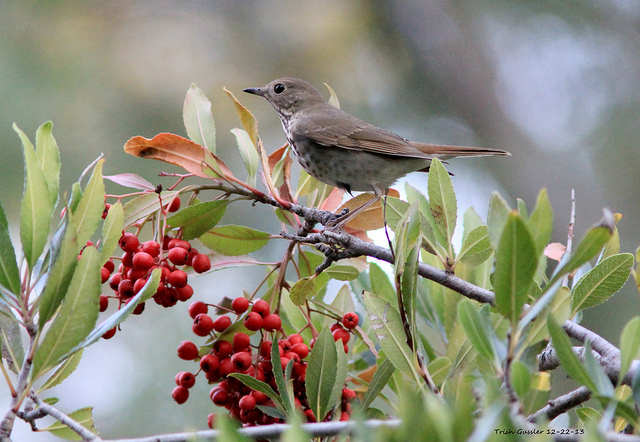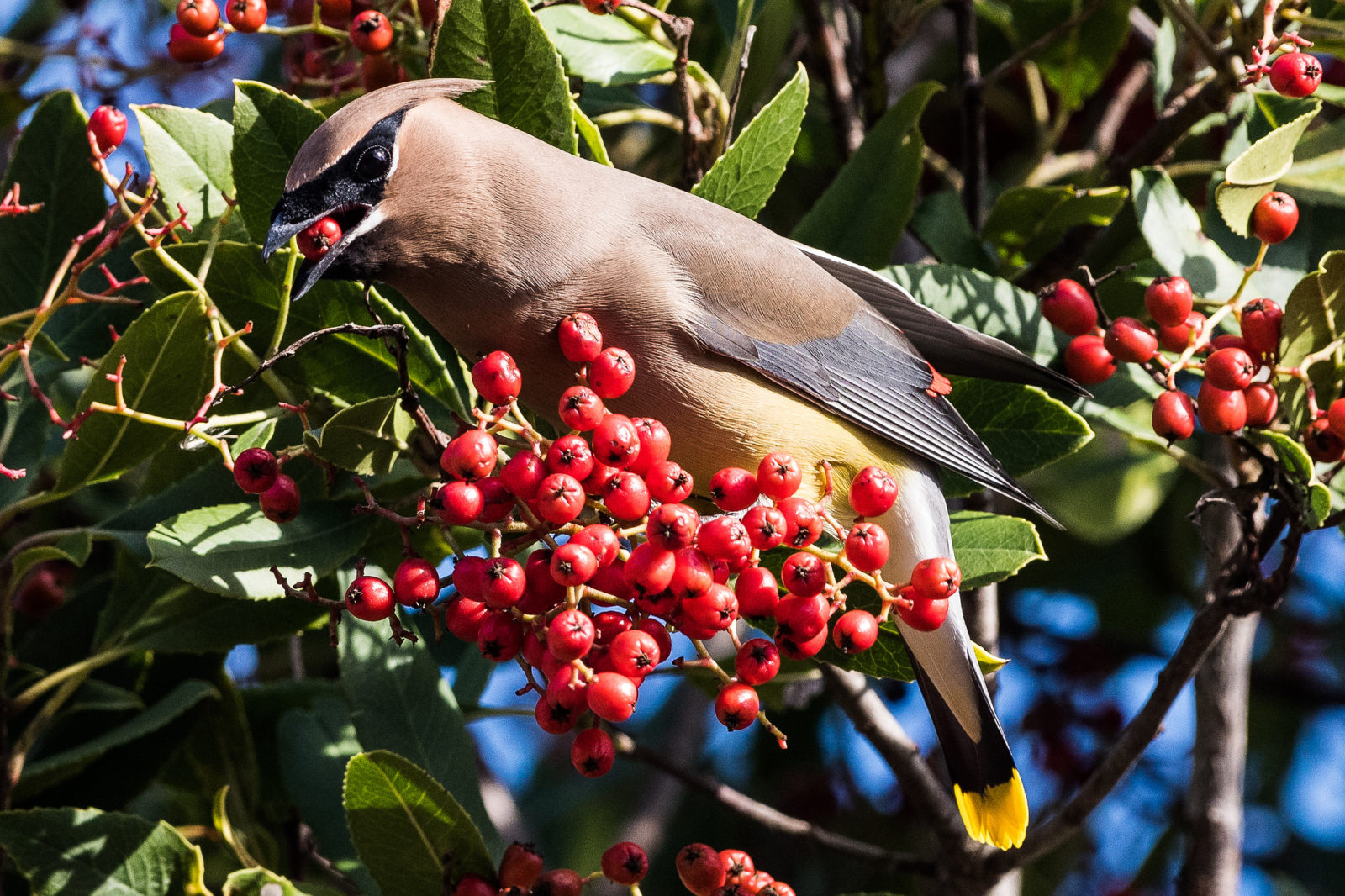The bright red berries of the toyon plant make this native perennial shrub a festive feature of the winter season in California.
These leafy bushes are common in chaparral and oak woodland habitats, but they are also well loved garden plants given their drought-tolerance and attractiveness for much of the year as the summer bloom of small, white flowers turns to an abundance of red berries in the fall, carrying well over into the winter months. Of course, we’re not the only ones who love those berries.
Bay Nature put this question to Alan Kaplan, a retired East Bay Regional Park District naturalist and birder: How important are toyon berries to the winter food chain?

Wintering birds in our area often depend on the fruits of native and exotic (ornamental) berry plants to sustain them. Three common fruit eaters are American robin, cedar waxwing, and hermit thrush.
In the 1970s, ornithologist Stephen Bailey looked at how these birds use berries in winter and how they interact with each other. (He was a graduate student at UC Berkeley at the time.) He found that toyon (Heteromeles arbutifolia) was the most important source of berries for robins, thrushes and waxwings, though they also make use of other berry plants on the university’s campus, such as cotoneaster, privet, pyracantha, holly and juniper.
Low in protein and calories, berries offer limited nutritional value, especially to small birds who need to consume their body weight in food each day to survive the winter. For example, a bird would need to consume 3 ounces of (dried) toyon berries to get the same 331 calories that could be had with only 2 ounces of sunflower seeds. Nevertheless, if you’re a wild bird you take what you can get!
Bailey found that he could learn a lot about bird behavior by watching them tackle a berried bush. Each of the three species he studied — American robin, cedar waxwing, and hermit thrush — had a different strategy of getting its fill. Each competed with the others and none could exclude the others altogether.
The large American robin throws its weight around, dominating the other birds when defending a rich bush of berries against individual hermit thrushes or a small number of cedar waxwings. Cedar waxwings, in turn, overwhelm the defense of robins with their large numbers, making up with flocking what they lack in fierceness.
Both the robins and waxwings prefer to perch and pluck at berries within reach, and spend about 16 minutes at a time doing that. Robins take five berries during that time, and cedar waxwings take three. A robin might eat its weight in berries in a day (about 3 ounces), filling and emptying its crop three times per hour. These birds must eat so much because the nutrient content of their food is low, and they digest it very rapidly (so less of the nutrients are absorbed).

Hermit thrushes skulk around very carefully and zip in and out of a bush, bagging one berry at a time from under the nose (beak) of the dominant robin. Robins and thrushes will also take fallen berries from the ground (waxwings will not), but the hermit thrush remains a sneak thief most of the time. It only gets about two berries per bout of feeding, but it, too, eats its weight in berries each day. The thrush would prefer to stay deep in a berry bush, eating as inconspicuously as possible. Some of the robins and thrushes do spend the entire winter in a single bush if it is rich enough in berries.
As the season progresses and food becomes scarcer, robins become more territorial and aggressive, and cedar waxwing flocks become larger in response.
Do plantings of toyon and exotic berry-bearers make a difference to overwintering birds? Yes! Populations of overwintering fruit eaters are more stable and more reliably found because there is a regular supply of berries. Fruit put out at bird feeders and ornamental plantings around homes have helped the northern mockingbird expand its winter range in the West (the seed-eating cardinal has profited similarly in the East). Shrubs, planted as ornamentals around homes, can be easily defended from other birds. The larger and more conspicuous the planting, the greater its chances of attracting cedar waxwings and American Robins.
And that is exactly why the plant produces its attractive berries in the first place (usually reddish and blackish colors predominate, though we don’t know why). The toyon goes so far as to have the short stems (pedicels) bearing the berries turn bright red, to be extra attractive to fruit-eaters and ensure that all the berries are eaten.
Berry eaters digest the nutritious coating and excrete the seed intact, helping it with a bit of fertilizer for a good start! Seeds are excreted away from the parent plant, reducing competition for water and sunlight.
For a lesson in food chain dynamics, go ahead and observe a local berry bush this winter. Note the abundance of fruit as the season begins, and then watch the change in the number of berries through the winter. You may be lucky to see a flock of cedar waxwings settling down to a mid-winter feast as the resident American robin tries in vain to beat them back. And, lurking nearby, ever ready to dart out for some really fast food, could be a hermit thrush.
Got a burning question about nature? Ask The Naturalist!





